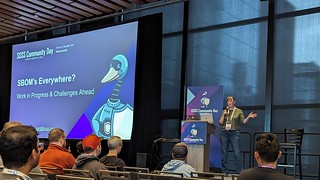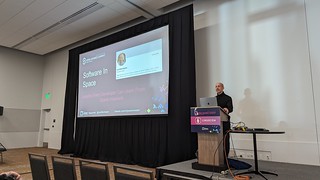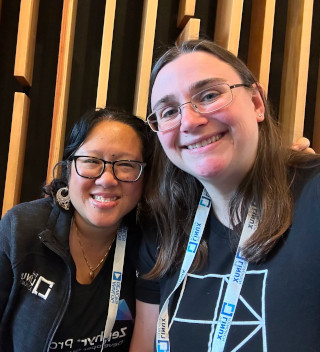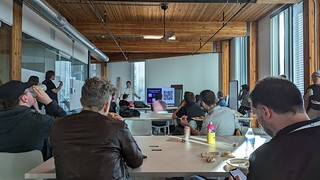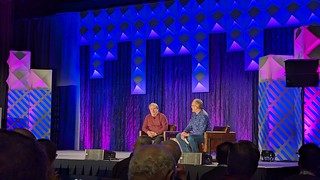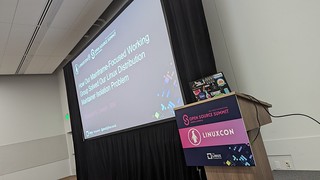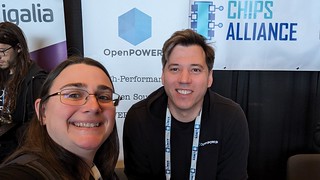My journey to the Open Source Summit North America came on the tail of the Texas Linux Fest, so I flew to Seattle from Austin on Sunday afternoon. A quick ride on light rail put me in downtown Seattle where a short walk got me settled in to my hotel that I’d call home base for the next few days.
Monday morning kicked off by going over to the Secure Open Source Software (SOSS) Community Day for the morning. I particularly enjoyed the keynote from Kate Stewart about the state of Software Bill of Materials (SBOMs). I remember when discussion of SBOMs in the open source world started picking up, also with Kate being a spokesperson for them, and at the time reflected upon how useful they’d be if they ever caught on. It feels like the increased focus on security due to some high profile vulnerabilities is what accelerated the interest and need for them and having a full keynote devoted to them at a security event seems to have confirmed my suspicions. It was great to get an overview of the types of SBOMs that exist (binary vs. source, where they are in phase of development/deployment), but also to learn how many governments have started mandating SBOMs to track what software they’re using. They’ve really hit their stride, and also launched SPDX 3.0, the latest in their iterations of “an open standard capable of representing systems with software components in as SBOMs.”
Monday afternoon took me over to CHAOSScon. I learned from their latest Community Health Analytics in Open Source Software (CHAOSS) project overview that they have a OSPO Metrics Working Group, which may be right up my alley these days. CHAOSS is one of those projects that I remember being launched and always wanted to be involved with, but never managed to make time for. I am concerned that’s still the case, but it was nice to check in with the community so I can more effectively determine whether it’s something I can finally carve out time for. We did an interactive workshop where we shared some thoughts and ideas, and then concluded with updates from a few of their projects, including the announcement of GrimoireLab 1.0 and an update from Augur.
I followed my friends (old and new!) to a CHOASScon after event at a nearby bar where I got to chat with a woman I met whose company was exploring their open source stack and thinking about building out an OSPO. It was nice having that conversation, as well as catching up with a bunch of folks.
Tuesday moved us beyond Community Day and officially kicked off the Open Source Summit, where we were welcomed to a series of keynotes that jumped right in with the topic of AI and work that’s going into enterprise-readiness with the launch of the Open Platform for Enterprise AI (OPEA). It was also nice to see quantum readiness mentioned. A keynote on Valkey, a Redis successor, also caught my attention, as there was a recent proposal to drop s390x support from it (thankfully a quick chat at their booth hopefully resolved this, hooray for conferences!).
Beyond the keynotes, it was generally a good day for talks. Kara Sowles of GitHub gave a great talk on open source funding (hint: there’s not nearly enough of it) and I went to a talk by my former colleague, Javier Perez, on some trends in open source software gathered from a survey that was concluded last year. Joe Winchester delighted with a talk on “Software in Space: Lessons Every Developer Can Learn From” where he took several examples of failures (or near failures) in space missions and drew parallels as to what software developers could learn. I think we all geeked out a bit over space science in that one.
Then for lunch I met up with Maemalynn Meanor of The Open Mainframe Project so I’d have a pal at the Women and Non-Binary Lunch, which is always a pleasure to attend.
Tuesday evening I made it over to a Open Source Summit [unofficial] AI Meetup After Hours which had a series of short talks from folks in the community to present their work, and what ultimately led to discussing ways they could collaborate, which was great to see. One of the things that came up was that even within the Linux Foundation community there is duplication of effort happening as everyone sees the same problems inside their own projects, meetups like this help break down those barriers.
Wednesday morning keynotes began with a “fireside chat” with Linus Torvalds, where he notably (for me) talked about RISC-V and concerns that they’d duplicate mistakes of past architectures when it came to software. When I stopped by the RISC-V booth later in the day it was clear that hit a nerve, and inspired some action in that community to make sure then don’t. He also seems to have come to the logical conclusion that the AI wave is not really worth the hype, but there is something there that we’d be wise to keep up with. Speaking of which, another keynote touched upon the rise of code being generated by AI tooling, and the need for securing our communities against manipulation that can happen to the source code bases that the AI is drawing from, underlining again that we need to bring trust and validation directly to open source projects.
After lunch I gave my talk on “How Our Mainframe-Focused Working Group Solved Our Linux Distribution Maintainer Isolation Problem” where, just like SCALE, I found myself with a small but deeply engaged audience. I also learned that while a handful of people in the room where focused on the topic, most of the questions were specifically related to mainframes, which I was also happy to answer! It was nice validation that there is appetite for the topic at events, and maybe I’ll re-focus on the technology at the next event I propose for, rather than going for a more social talk. Still, I was very happy I gave it, and some great contacts seem to have been made both for myself and for some audience members who got chatting afterwards.
Thursday was when the realization that I was on day eight of travel finally hit me and I started feeling a bit tired and I switched to mostly spending time in the expo hall meeting with people rather than trying to focus on sessions. Throughout my expo hall adventures I got to meet up with some friends from the Ubuntu community, a contact who I’d only spoken with online from OpenPOWER, and dozens of people I’ve known through various times in my career, who I’ve always been able to geek out with, regardless of my current focus – including mainframes!
Still, I caught the keynotes which were, once again, a bit AI-heavy. It’s important though, I know the tech industry is saturated with AI at the moment, but one of the things the Linux Foundation has the opportunity to be a steward of is the responsible development and use of it, so I’m grateful to see that coming together. Thursday was also delightfully broken up by the ability to pet some animals. I chose the rabbits.
The Open Source Summit is the largest open source events I attend, so I was really grateful to be back after the pandemic hiatus. I had a plan for the week, and accomplished most of what I planned on, but was constantly surprised at other opportunities that sprung up when I met with people. As valuable as the regional conferences are (and they ARE), this one is definitely the best conference of the year for core open source networking.


